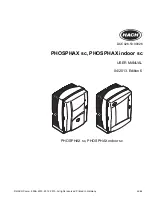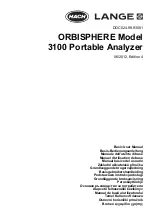
341350A-en-US_V1.3 8/15
5
pH
Calibration
(1,
2,
or
3
points)
A
two
point
calibration
with
a
buffer
of
7
plus
4
or
10
(whichever
is
nearest
to
the
expected
sample
value)
is
always
recommended.
A
one
point
calibration
(choose
the
value
closest
to
the
expected
sample
value)
or
a
three
point
calibration
is
also
valid.
For
best
accuracy,
always
calibrate
at
the
sample
temperature.
Frequency
of
calibration
is
dependent
on
how
often
the
meter
is
used,
the
care
of
the
electrode,
and
strength
of
the
samples
tested.
Typically,
it
is
recommended
that
calibration
be
performed
once
a
day;
or
before
each
use
if
the
meter
is
not
used
on
a
daily
basis.
1.
Connect
the
pH
probe
and
place
it
into
a
pH7
buffer.
2.
Press
the
POWER
button
to
turn
the
meter
on
and
press
the
MODE/CAL
button
until
the
PH
icon
appears.
(Note:
disable
the
Auto
Power
Off
feature
to
avoid
an
automatic
power
off
during
calibration).
3.
If
the
MTC
icon
appears
next
to
the
temperature
display,
press
the
▼
or
▲
button
to
set
the
temperature
of
the
pH
buffer.
If
the
optional
temperature
probe
is
used,
insert
the
probe
into
the
buffer
solution.
4.
Press
and
HOLD
the
MODE/CAL
button
until
the
display
begins
to
flash
‘7.00’.
The
meter
automatically
recognizes
the
buffer
and
calibrates
itself
to
that
value.
At
the
end
of
the
calibration
cycle,
SA
and
End
will
briefly
appear
on
the
display
and
the
meter
will
return
to
the
normal
operating
mode.
5.
When
a
calibration
is
performed,
the
calibration
icons
(pH10)
(pH7)
(pH4)
will
be
cleared
(calibration
data
is
not
erased)
and
will
be
replaced
when
a
successful
calibration
is
performed
for
each
buffer
within
one
power
on
cycle.
These
icons
indicate
what
calibration
levels
were
last
performed.
They
do
not
indicate
how
recently
the
calibration
was
performed
or
if
the
calibrations
are
still
valid.
6.
Remove
the
electrode
from
the
pH7
buffer,
rinse
in
a
rinse
solution
and
insert
it
into
the
pH4
or
pH10
buffer
solution.
7.
Repeat
step
4
for
the
second
calibration
point
and
then
the
third
point
if
desired.
Note:
If
the
output
of
the
electrode
falls
outside
predetermined
limits,
the
meter
will
cancel
the
calibration,
indicate
End,
and
flash
the
RENEW
icon.
This
typically
happens
when
the
electrode
has
aged
and
needs
replacement.
Note:
To
avoid
cross
contamination,
always
rinse
the
electrode
in
a
rinse
solution,
like
distilled
water,
when
changing
from
one
buffer
or
sample
to
the
next
buffer
or
sample.
ORP
Calibration
The
ORP
electrode
does
not
require
calibration.
However,
you
can
test
the
ORP
probe’s
accuracy
using
an
ORP
standard.
www.
GlobalScientificSupply
.com
GLOBAL SCIENTIFIC SUPPLY
The Laboratory Supply Company!





























